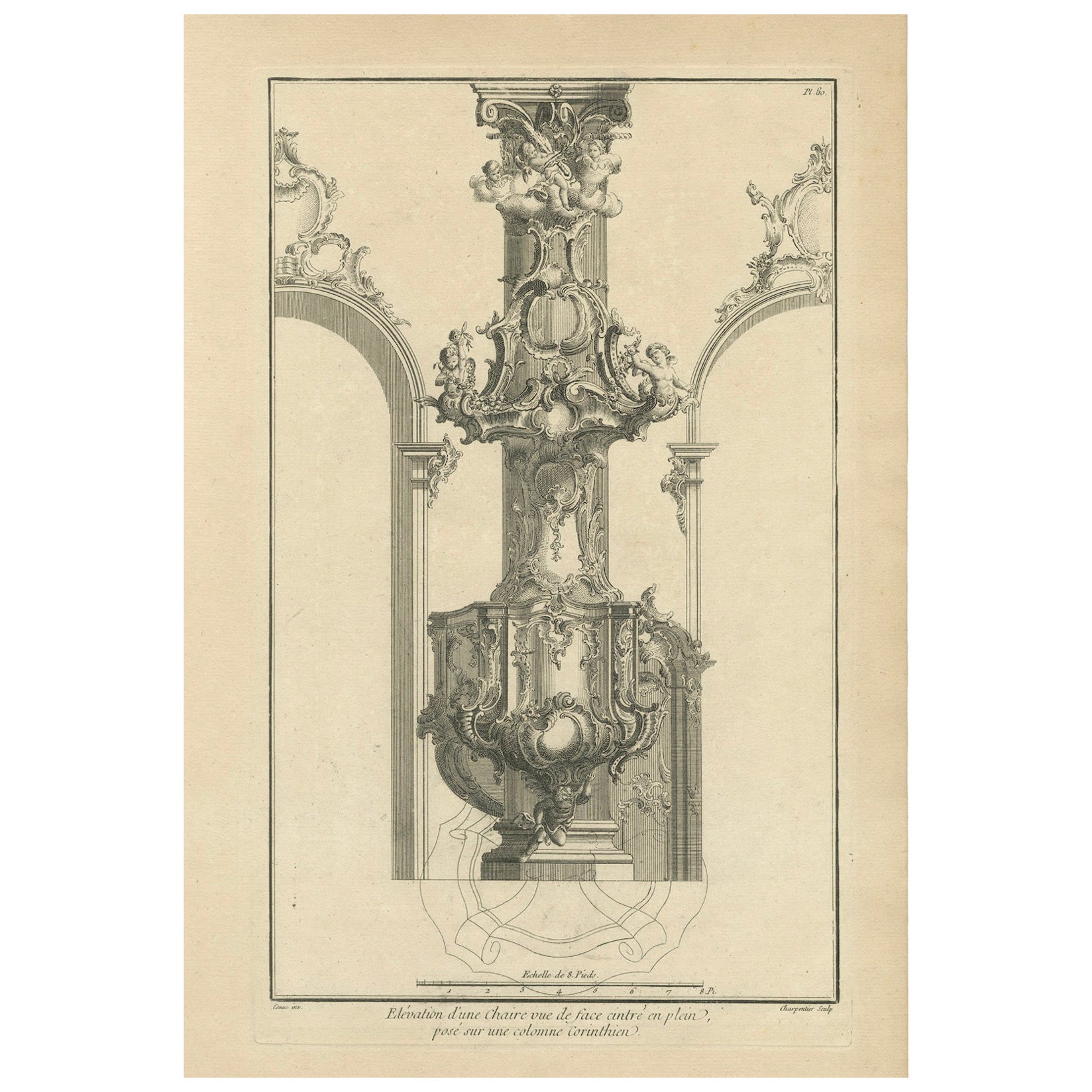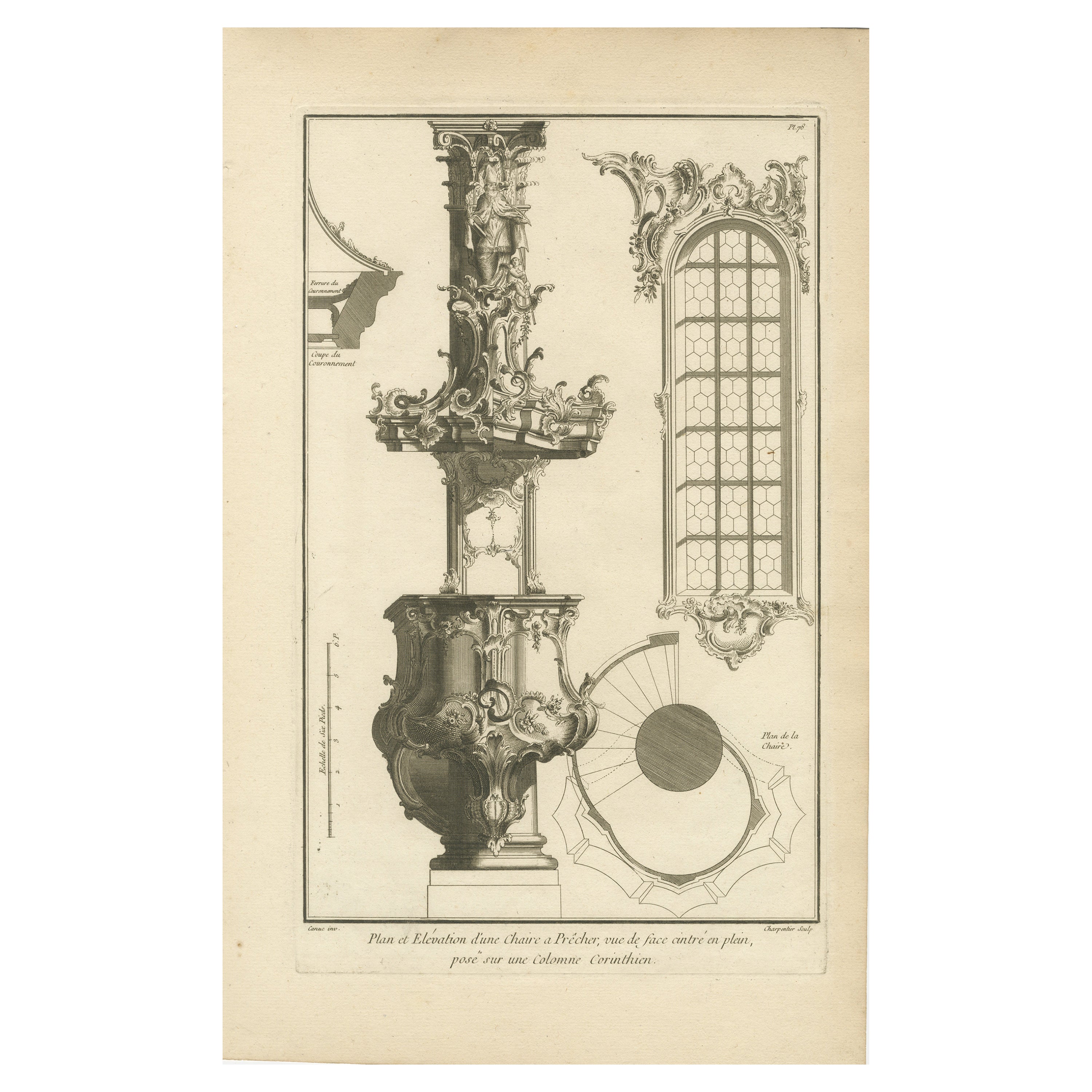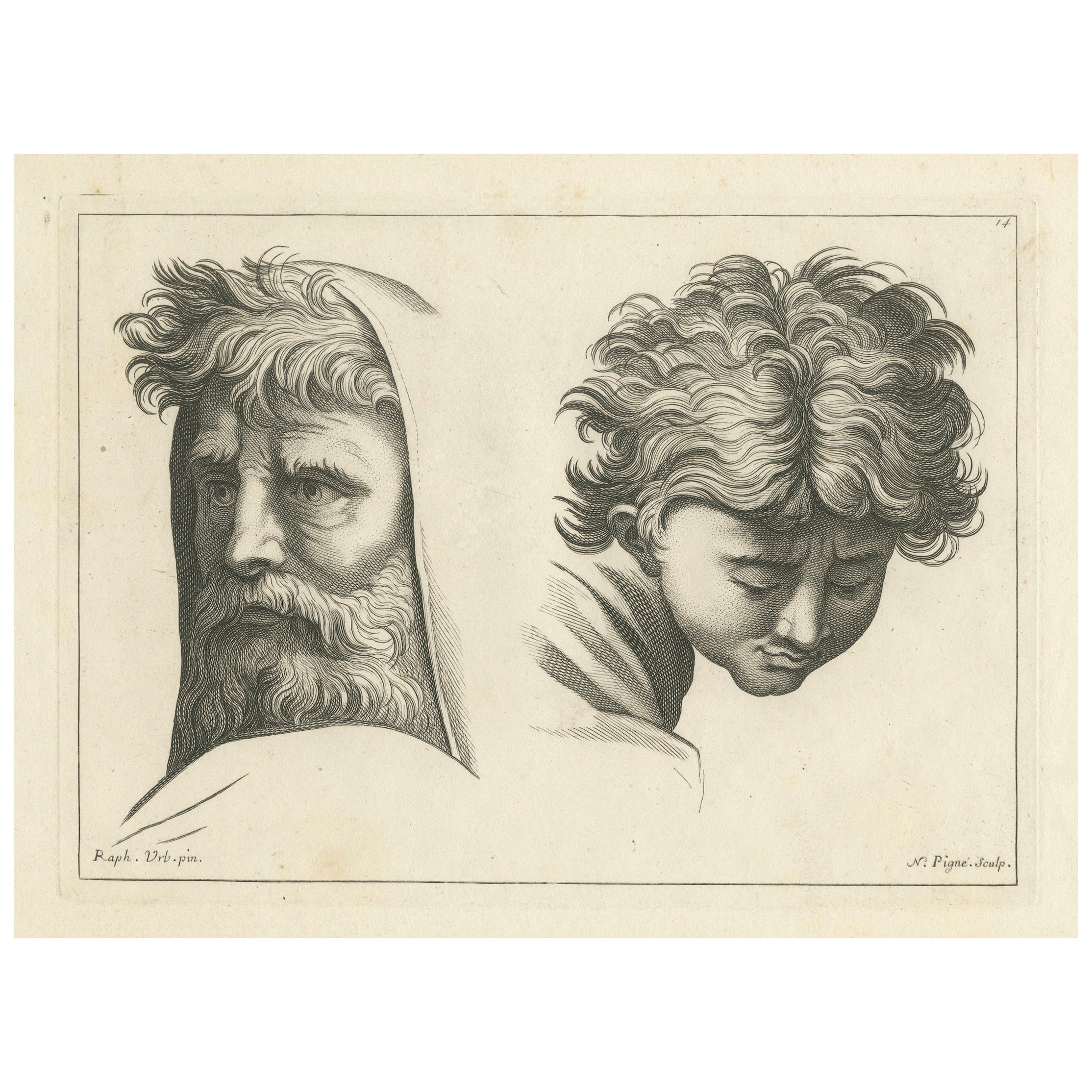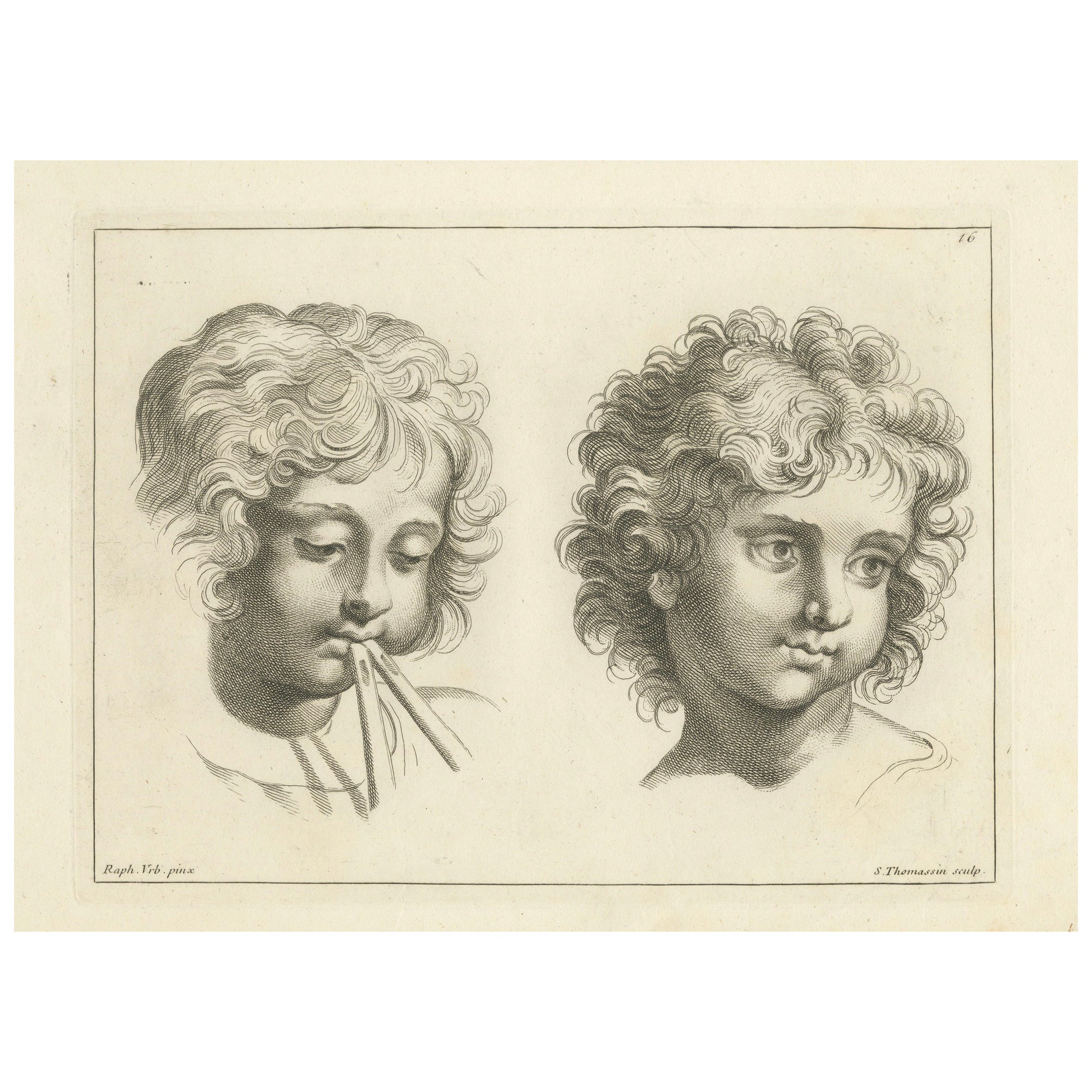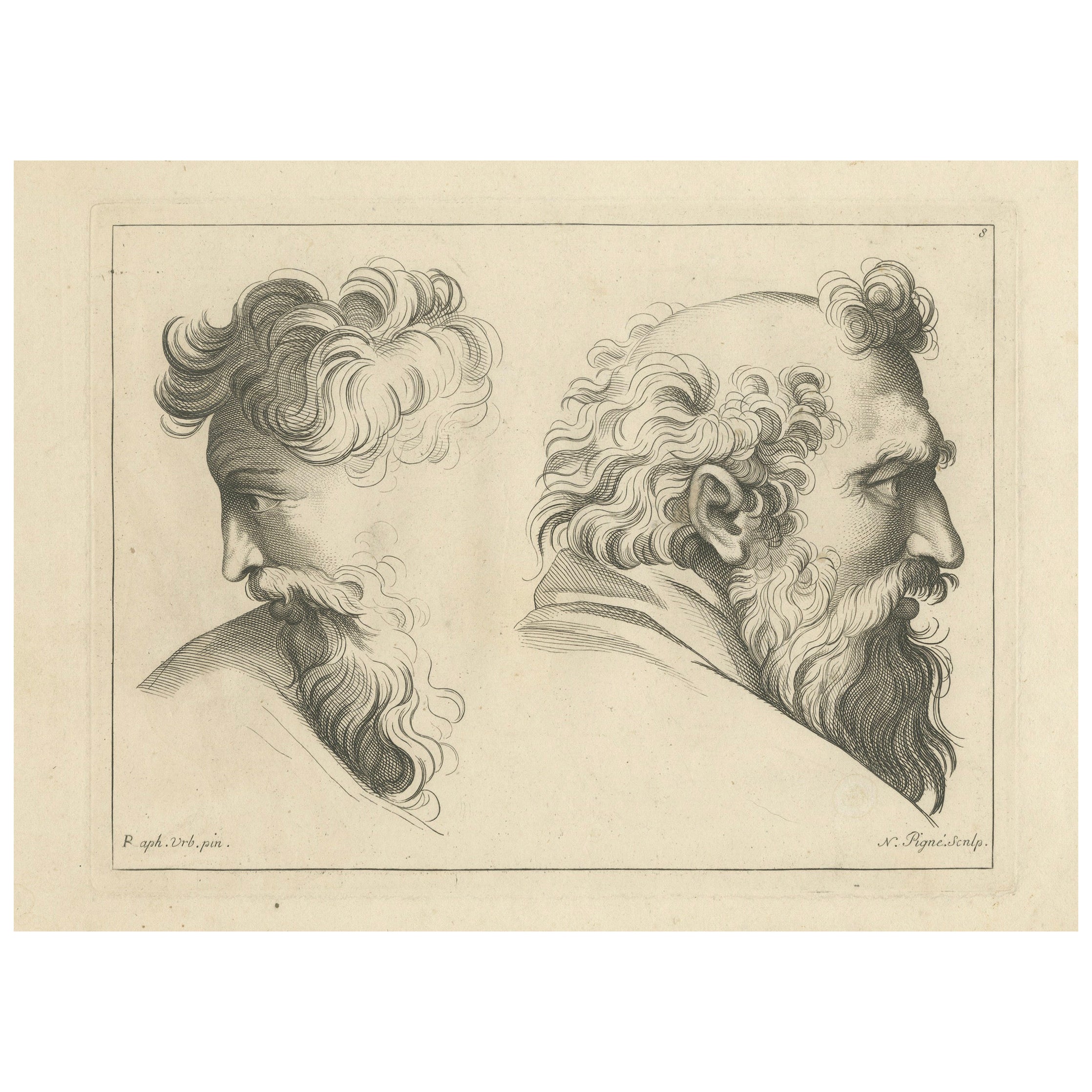Items Similar to Baroque Pulpit Elevation with Ornate Archway and Balustrade Engraved, ca.1740
Want more images or videos?
Request additional images or videos from the seller
Baroque Pulpit Elevation with Ornate Archway and Balustrade Engraved, ca.1740
About the Item
This is an original antique architectural design for a pulpit in baroque style with archway and balustrade dating approximately between 1740 and 1760.
The artist responsible for this design is Franz Xaver Habermann, and it was published by Johann Georg Hertel I in Augsburg. The design shows a richly decorated pulpit and archway, typical of the Rococo style, which is known for its elaborate ornamentation, asymmetry, and curves. This image is one of four numbered plates related to this work. The detail in the engraving is meticulous, showcasing the elaborate aesthetic that characterized much of the European art and architecture during the mid-18th century.
Franz Xaver Habermann (1721–1796) was a German engraver and etcher who was active during the 18th century, a period marked by the Rococo style. Although not as widely known as some of his contemporaries, Habermann contributed significantly to the graphic arts during his time.
Habermann's work often featured architectural designs, such as the intricate pulpit depicted in the image you've provided. He was skilled in creating prints that detailed elaborate decorative schemes and architectural fantasies, which were popular during the Rococo period. His creations were known for their intricate details and the fluidity of their lines, capturing the lightness and ornamental excesses that characterized Rococo design.
Johann Georg Hertel I, who published Habermann's work, was part of a notable family of engravers and publishers in Augsburg, a city that was an important center for publishing in Europe at the time. The Hertel family played a significant role in disseminating artistic and architectural designs through their publications.
While specific details about Habermann’s life and training may not be as well-documented as those of major artists of his time, his surviving works suggest that he was a highly skilled engraver who had mastered the Rococo style, contributing to the spread of this aesthetic through his printed works. His designs would have influenced the tastes of the period, both within Germany and across Europe, where the appetite for such elaborate designs was significant.
More in detail about this engraving:
This engraving displays a Baroque-era preacher's pulpit, rich in ornamental detail, positioned within an arched architectural setting. The pulpit itself is lavishly adorned with a variety of decorative motifs that are characteristic of the Baroque style, including intricate scrollwork, acanthus leaves, and possibly floral or vine-like elements, which add to its grandeur and opulence.
Above the pulpit, the arch is similarly embellished, with a central cartouche that appears to house a figure or emblem. This is flanked by two sculptural figures, possibly cherubs or putti, which are common decorative elements in religious Baroque art, symbolizing innocence and spirituality.
The balustrade extending from the pulpit is also finely detailed, indicating that the preacher’s platform is elevated and accessible by steps, suggesting a design that is both functional and aesthetically pleasing. The side view of the pulpit shows the depth and three-dimensional form of the structure, while the inclusion of a plan view at the bottom of the print provides a comprehensive understanding of the pulpit's design in space.
The print is meticulously executed, reflecting the skilled craftsmanship required to create such detailed engravings. It would have served as a design pattern for artisans of the time or as a means to document the elaborate design for patrons or for archival purposes. The overall effect is one of dramatic elegance, intended to inspire awe and reverence within the ecclesiastical setting.
Note from seller: In our shop we also published the other three engravings in this series and they might still be on offer as well.
- Dimensions:Height: 16.54 in (42 cm)Width: 10.44 in (26.5 cm)Depth: 0 in (0.02 mm)
- Materials and Techniques:Paper,Engraved
- Period:1740-1749
- Date of Manufacture:circa 1740
- Condition:Good, given age. Light soiling near paper edges. Light staining. Left paper edges a bit rough from binding. Very light creasing from handling. General age-related toning and/or occasional minor defects from handling. Please study scan carefully.
- Seller Location:Langweer, NL
- Reference Number:
About the Seller
5.0
Platinum Seller
These expertly vetted sellers are 1stDibs' most experienced sellers and are rated highest by our customers.
Established in 2009
1stDibs seller since 2017
1,949 sales on 1stDibs
Typical response time: <1 hour
- ShippingRetrieving quote...Ships From: Langweer, Netherlands
- Return PolicyA return for this item may be initiated within 14 days of delivery.
More From This SellerView All
- Original Antique Baroque Sermon Pulpit with Full Arch Elevation, circa 1740Located in Langweer, NLThis is an original antique architectural design for a pulpit in baroque style dating approximately between 1740 and 1760. The artist responsible for this design is Franz Xaver Hab...Category
Antique 1740s Prints
MaterialsPaper
- Architectural Print of a Rococo Pulpit Elevation on a Corinthian Column, ca.1740Located in Langweer, NLThis is an original antique architectural design for a rococo pulpit dating approximately between 1740 and 1760. The artist responsible for this design is Franz Xaver Habermann, an...Category
Antique 1740s Prints
MaterialsPaper
- Old Baroque Pulpit Design with Corinthian Column and Staircase Plan, ca.1740Located in Langweer, NLArchitectural design with the central elements depicted in the engraving: the Baroque design of the pulpit, the inclusion of a Corinthian column which suggests a classical influence, and the presence of a staircase plan indicating the approach to the pulpit. Dating approximately between 1740 and 1760. The artist responsible for this design is Franz Xaver Habermann, and it was published by Johann Georg Hertel I in Augsburg. The design shows a richly decorated pulpit and archway, typical of the Rococo style, which is known for its elaborate ornamentation, asymmetry, and curves. This image is one of four numbered plates related to this work. The detail in the engraving is meticulous, showcasing the elaborate aesthetic that characterized much of the European art and architecture during the mid-18th century. Franz Xaver Habermann (1721–1796) was a German engraver and etcher who was active during the 18th century, a period marked by the Rococo style. Although not as widely known as some of his contemporaries, Habermann contributed significantly to the graphic arts during his time. Habermann's work often featured architectural designs, such as the intricate pulpit depicted in the image you've provided. He was skilled in creating prints that detailed elaborate decorative schemes and architectural fantasies, which were popular during the Rococo period. His creations were known for their intricate details and the fluidity of their lines, capturing the lightness and ornamental excesses that characterized Rococo design. Johann Georg Hertel I, who published Habermann's work, was part of a notable family of engravers and publishers in Augsburg, a city that was an important center for publishing in Europe at the time. The Hertel family played a significant role in disseminating artistic and architectural designs through their publications. While specific details about Habermann’s life and training may not be as well-documented as those of major artists of his time, his surviving works suggest that he was a highly skilled engraver who had mastered the Rococo style, contributing to the spread of this aesthetic through his printed works. His designs would have influenced the tastes of the period, both within Germany and across Europe, where the appetite for such elaborate designs was significant. More in detail about this engraving: This engraving features a detailed representation of a Baroque-style preacher's pulpit, intricately designed and placed upon a Corinthian column, demonstrating the grandeur of religious architecture during the Baroque period. The pulpit is richly adorned with elaborate scrollwork, acanthus leaves, and possibly religious iconography, all common elements in Baroque ecclesiastical design. A significant feature of this print is the inclusion of architectural details such as the Corinthian column base, known for its ornate capital with acanthus leaves and scrolls, which supports the pulpit above. This classical element signifies stability and order, providing a stark contrast to the exuberant decoration of the pulpit itself. To the right of the pulpit, there's a tall, slender window filled with panes that could either be clear or stained glass, framed by an ornate window arch...Category
Antique 1740s Prints
MaterialsPaper
- Wisdom and Innocence: Contrasts in Time Engraved by Pigné, 1740Located in Langweer, NLThis engraving by Nicolas Pigné, part of the "Recueil de XC Têtes tirées des Sept Cartons des Actes des Apôtres" collection, shows a stark contrast between two figures. On the left, ...Category
Antique 1740s Prints
MaterialsPaper
- "Cherubic Melody: Raphael's Vision, Engraved by Thomassin, 1740Located in Langweer, NLThe engraving features two cherubic faces, each blowing an object that is not fully visible, which may be a wind instrument, giving life to an unseen melody. The cherubs, with their ...Category
Antique 1740s Prints
MaterialsPaper
- Renaissance Reflections: Engraved by Pigné, Directed by Dorigny, 1740Located in Langweer, NLThis engraving is part of the ambitious project overseen by Sir Nicolas Dorigny, "Recueil de XC Têtes tirées des Sept Cartons des Actes des Apôtres," which translates to "Collection ...Category
Antique 1740s Prints
MaterialsPaper
You May Also Like
- Vintage 1930s Charles Bowling Archway of Trees EtchingLocated in Seguin, TXVintage circa 1930's etching on paper by Charles T. Bowling (1891 - 1985) Texas. He was active in the pre-World War II group of Regionalist artists known as the Dallas Nine. Signed...Category
Vintage 1930s American Arts and Crafts Prints
MaterialsPaper
- Homero Aguilar Feu Sacre Giclee Print Canvas Colonnade Archway ExpressionismLocated in Dayton, OHVintage giclee print on canvas of “Feu Sacre” by Homero Aguilar. Marked BH6-3181 and signed on the verso. “Born in Pasto, Colombia in 1953, Homero Ag...Category
Late 20th Century Modern Prints
MaterialsCanvas
- Framed Early 19th Century Drawn and Engraved Map of ChinaBy John Knighton ThomsonLocated in San Francisco, CAHand drawn and tinted engraved map of China dated 1815 Created for Thomson's New General Atlas Edinburgh Beautifully framed with a linen covered mat.Category
Antique Early 19th Century European Prints
MaterialsPaper
- Original Antique Map of Spain and Portugal, Engraved By Barlow, 1806Located in St Annes, LancashireGreat map of Spain And Portugal Copper-plate engraving by Barlow Published by Brightly & Kinnersly, Bungay, Suffolk. 1806 Unframed.Category
Antique Early 1800s English Maps
MaterialsPaper
- Insectario / Mantis / Engraved /Grabado / Sergio HernándezBy Sergio HernándezLocated in COYOACAN, DFSergio Hernández was born in 1957 in the town of Santa María Xochistlapilco, located near Huajuapan de León, in the Sierra Mixteca. He studied at the ...Category
21st Century and Contemporary North American Modern Prints
MaterialsPaper
- Mirror Frame With Engraved Dutch Print Depicting Dukes Of Mirandola Coat Of ArmsLocated in Prato, TuscanyWe kindly suggest that you read the entire description, as with it we try to give you detailed technical and historical information to guarantee the authenticity of our objects. The ...Category
Antique Mid-17th Century Dutch Modern Prints
MaterialsWood, Paper

